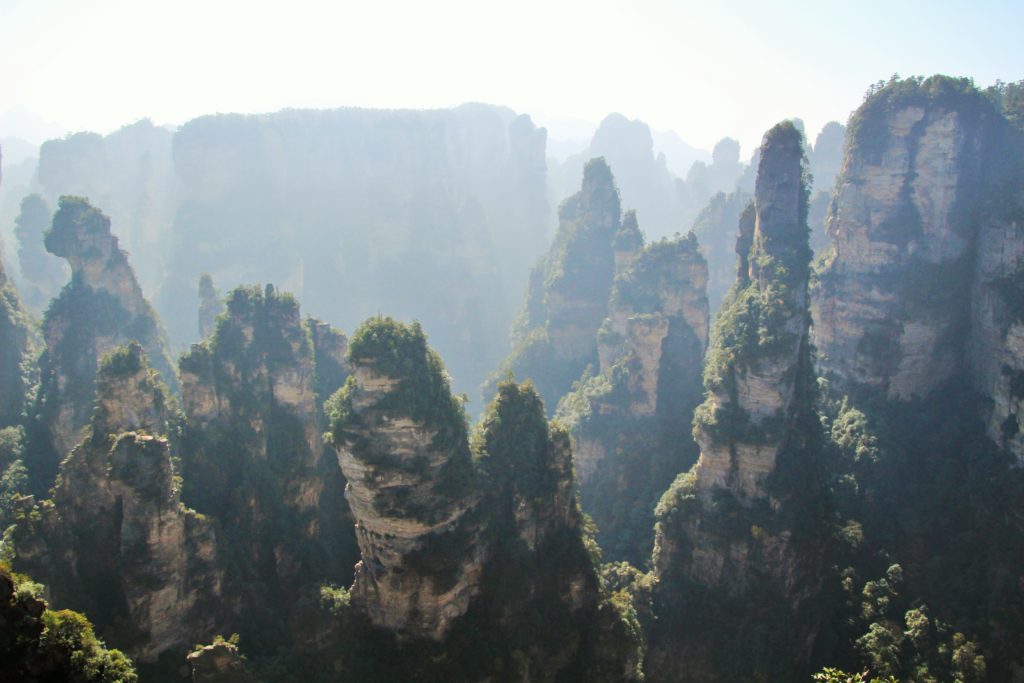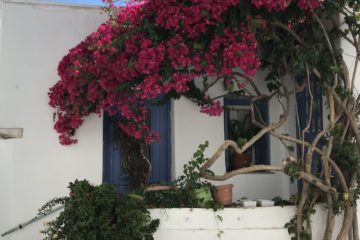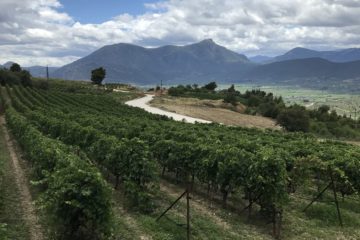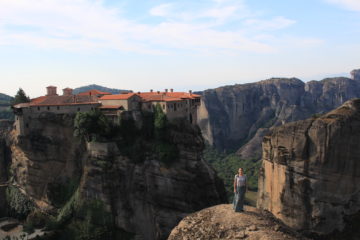Our last stop in China (!!) – Zhangjiajie National Forest – was the one Rorie was most excited for, and after hearing him talk about it, I was too. [Editor’s note: While we shared excitement to see most of the sights in China, we were each allowed to select an indulgence to visit. Jess really wanted to do the Mongolian grasslands, which is why we went there. I really wanted to go to Zhangjiajie. Neither was the most convenient, but both were worth it (especially mine, though I’m biased).] This park has unique rock formations and general scenery that is supposed to be out of this world, almost literally, as it is widely understood to have inspired the planet Pandora (the floating mountains) in the movie Avatar.
Rorie did a lot of research into different ways to see the best parts of the park, and the more he read the more potentially confusing it seemed. Though this is a national park, there are villages and hostels inside the park as well as outside, cable cars and buses to take you around (the buses are free, the cable cars are not), and several entrances to the park in completely different cities – it was a lot of information that also created a lot of (too many?) options. We tackled all this by splitting the planning in terms of scale: Rorie took on the bulk of the early research, and did all the macro planning of how many days and nights we would be there, which towns/cities we would be staying in each night, and which days we would do the park versus the mountain. Then, once we were there, I took on the micro planning of looking at the park map and determining our specific route each day, which buses and cable cars we would take and in what order so as to maximize our sightseeing in a reasonable path.
It worked out well, so what follows is the itinerary we ended up with and, of course, the star of the show in lots and lots of pictures.
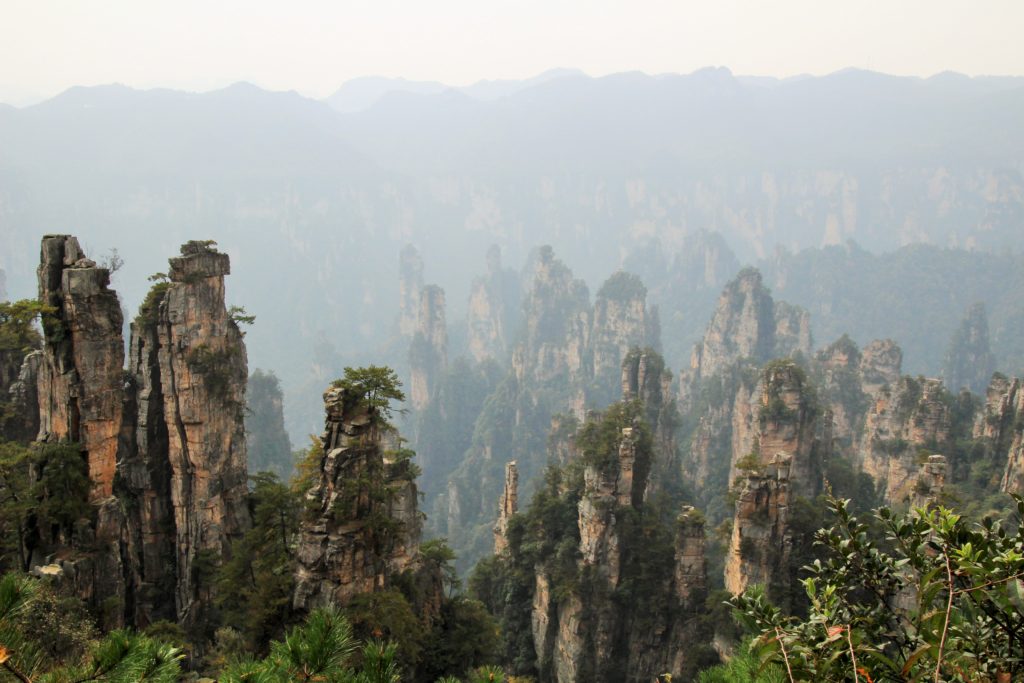
Yep. Just one of many spectacular views.
Day 0-1: We arrived in Wulingyuan, a small town near one of the entrances to Zhangjiajie National Forest. We made sure to have two full days in the park, which was a good amount to see most of the major areas and sights and was possible because the entrance pass was valid for four days. I had spent probably hours poring over the park map we got from our extremely helpful hostel owner, cross-referencing it with other blogs I read about the routes that others too. Our first step was the Tianzi cable car up to the top of the plateau, which provided a surreal beginning to the trip by immediately whisking us between impossibly tall pillars of stone, allowing us to looking up at them as we flew through the air. We had a cable car to ourselves after getting there around 8:30 or 9am, and we stared out every direction of the car, unable to decide which direction was the most spectacular. I immediately felt as though I was truly in Avatar, flying through the towering mountains. [Editor’s note: To help Jess actualize this fantasy, we made sure to get a picture of her posing on a statue of the flying creatures from Avatar so that her dream would come true. Note that for her to take this picture, she had to wait in line with various other children and withstand the stares (and stray camera shots) of other Chinese tourists. No big deal.] We already knew it was the right decision to put this park on our China itinerary.
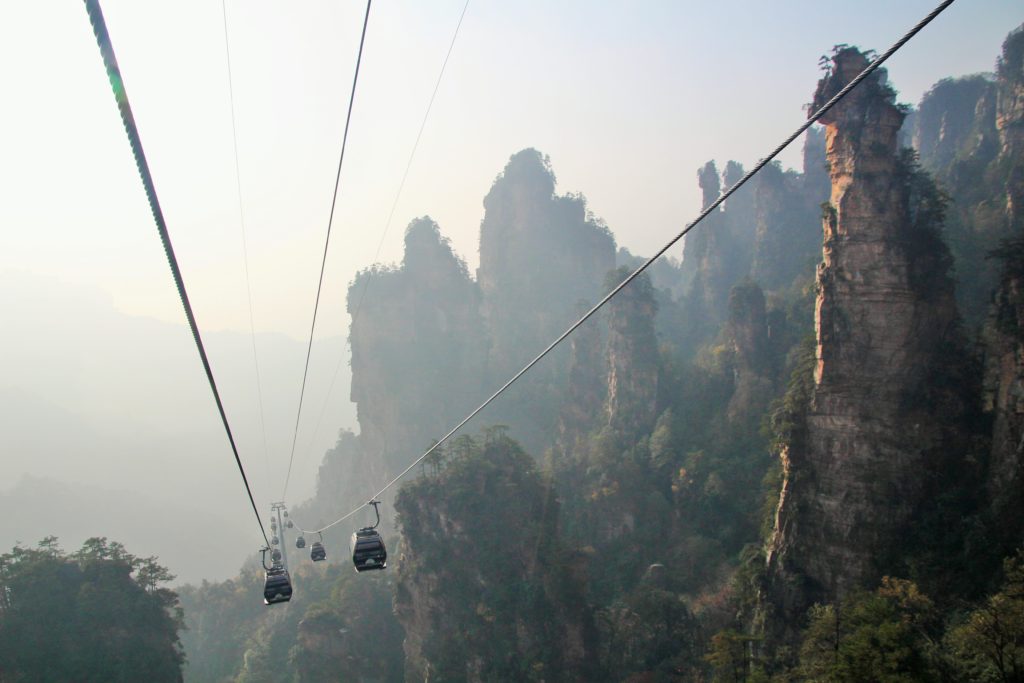
Our first views of Zhangjiajie. Quite the introduction, don’t you think?
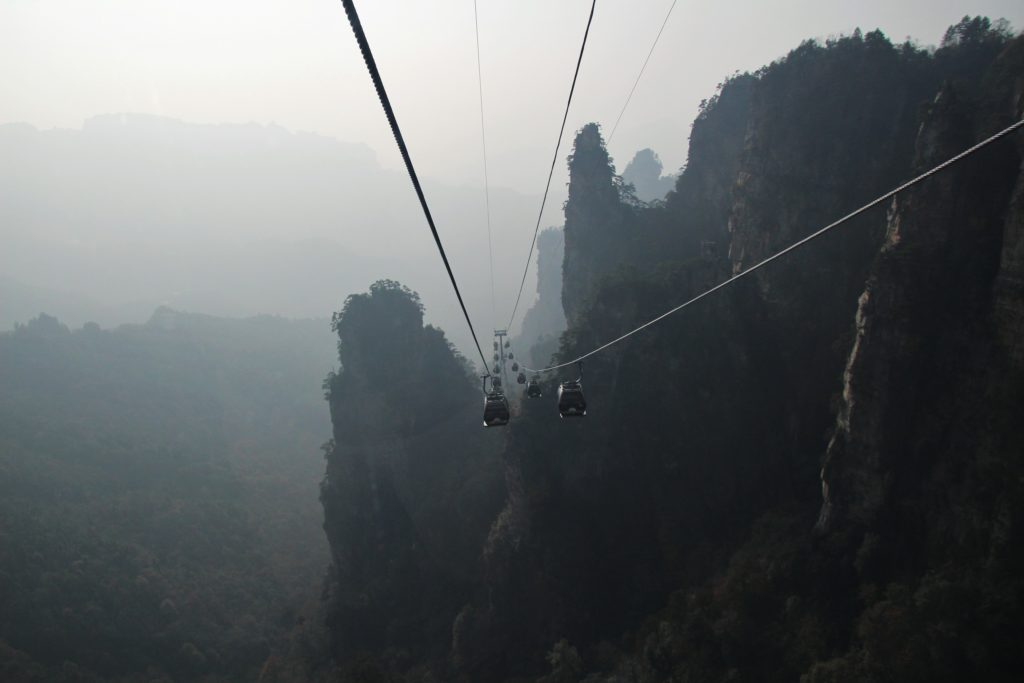
Another one from the cable car, because why not, with scenery like this?
When we got to the top, we started by going an area of sights that Lonely Planet and other blogs had touted as being good. But when we got there, it was really hard to find and essentially unmaintained, in stark contrast to all the other vantage points in the park. In fact, our free tourist bus didn’t even stop at the turnoff, forcing us to walk back along the road to find it despite some English-speaking tourists telling us they gave up because they couldn’t find the trail. Once we eventually found it, the trail was honestly really strange since the combination of the off-the-path location, the disrepair, and the early timing of our visit meant that we were the only people on this entire portion of path. Given that we had heard horror stories about the crowds and lines all over the park, this was simultaneously wonderful and a little disconcerting.
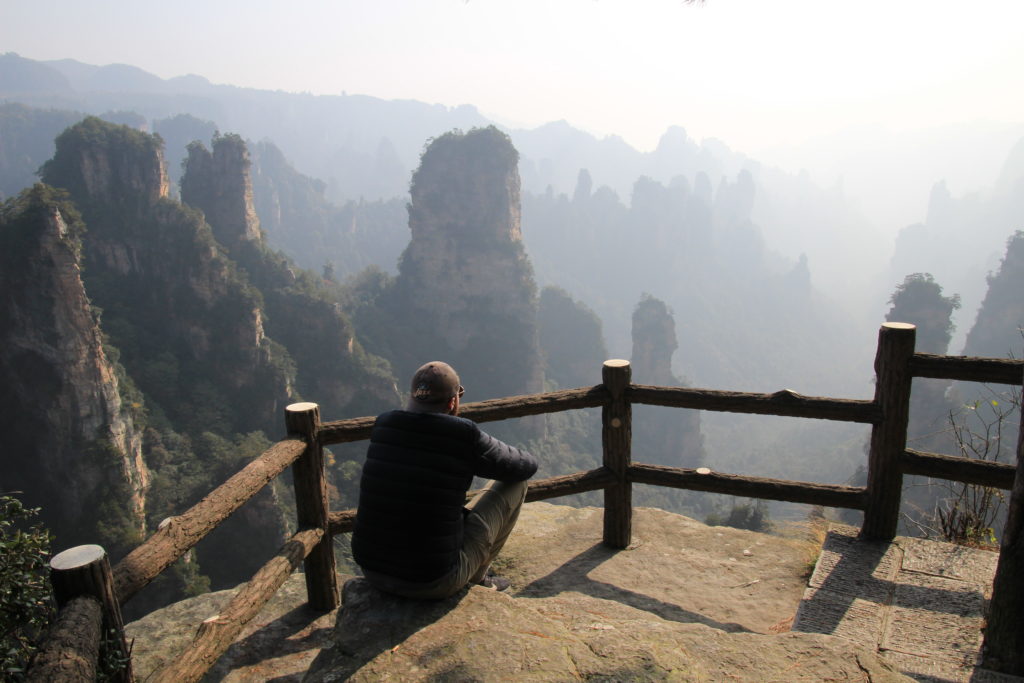
Rorie surveys the landscape from our deserted overlook
It ended up a mixed bag – one or two of the overlooks were spectacular [Editor’s note: The best overlook had a truly exemplary name: God Chicken Pecking. The Chinese really are phenomenal at naming stuff.], and we had them entirely to ourselves, but the others were pretty unremarkable and overall not worth the hundreds of steep stone stairs we had to hike to get there and back. I still don’t understand why this section was in such disrepair, but it certainly made for an interesting and unexpectedly solitary first morning in the park! [Editor’s note: My theory is that there was a lookout point called the Fairy Bridge, which is a natural stone bridge connecting two karsts. I think this route used to be quite popular when tourists were allowed to walk over the bridge, but it fell out of favor once they eliminated access to it. I can’t confirm this, but I think that’s why it was empty.]
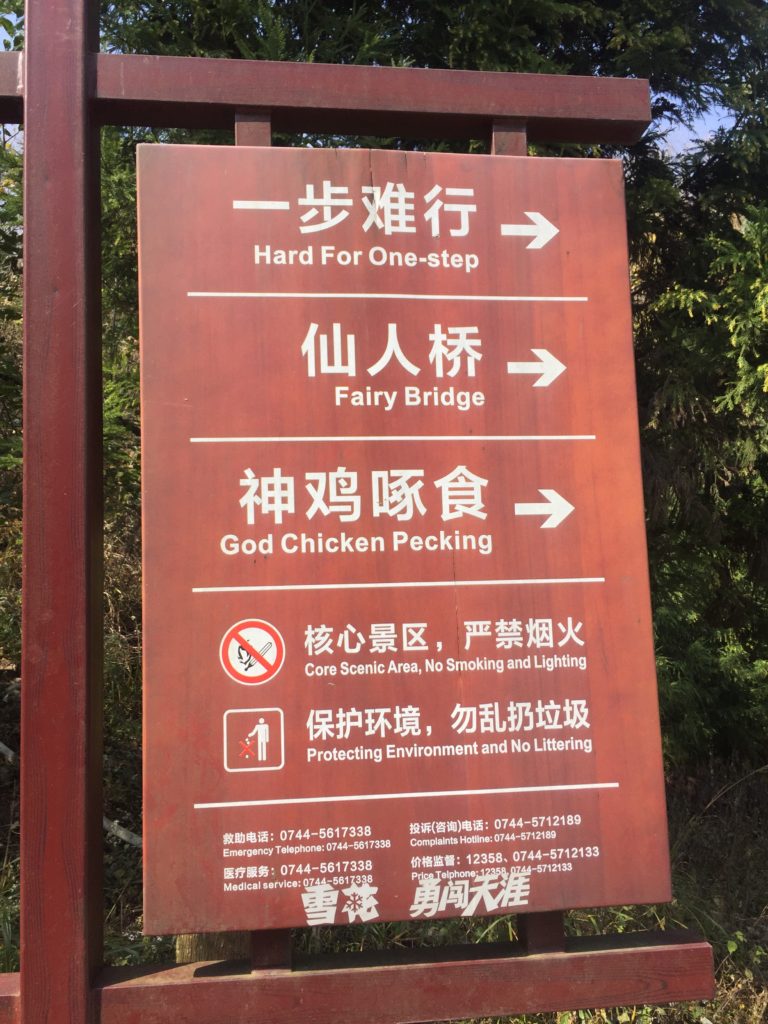
God Chicken Pecking, and other well-named points of interest.
After huffing our way back up the stairs on this portion of path, we caught another free bus back to a more popular section of the trail, where we ate lunch at one of the many food vendors and then had to fight our way through jostling tour groups to get photos from small but incredible overlooks. The views were even better than the morning, though the crowds did detract from the experience as it was hard to really stand and enjoy the amazing scenery. But seriously, the scenery was amazing. The park is full of karsts, which are the tall skinny pillars of stone that give the site its unique beauty. These karsts are covered with trees and bushes that hang on to the rock in seemingly impossible ways, attaching to every crevice and surface possible. The tops of the karsts are all at relatively the same height, causing it to look less like a mountain range and more like a flat plateau that had broken apart into individual spires. These karsts extend off into the distance as far as you can see before disappearing into the haze. You can absolutely see how a movie director would want to incorporate this type of landscape into a fantastical world.
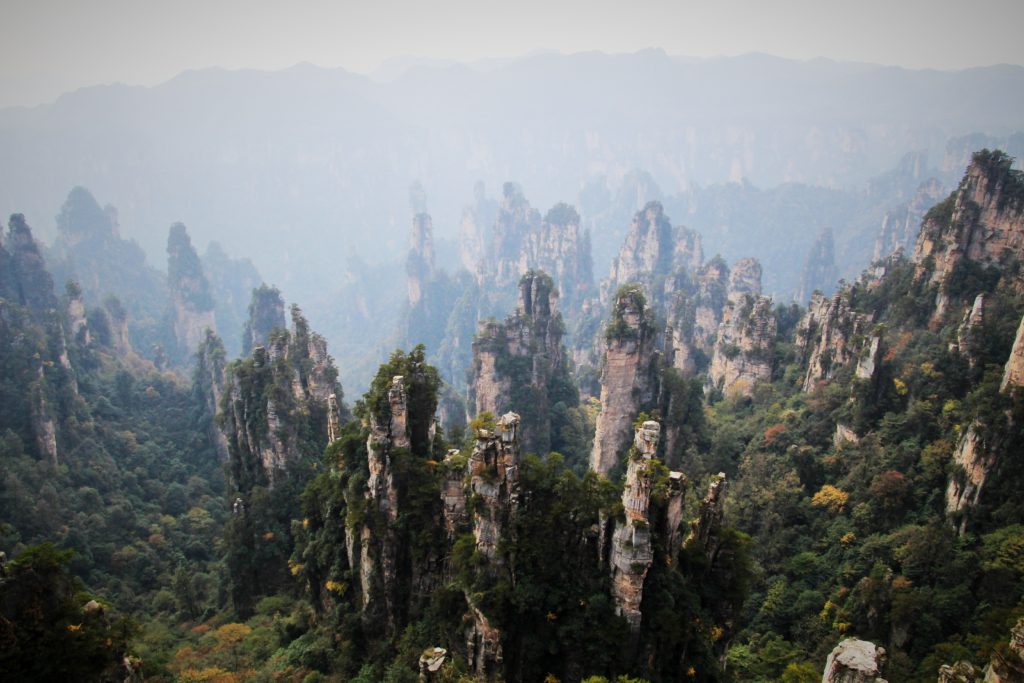
Unreal scenery at Zhangjiajie.
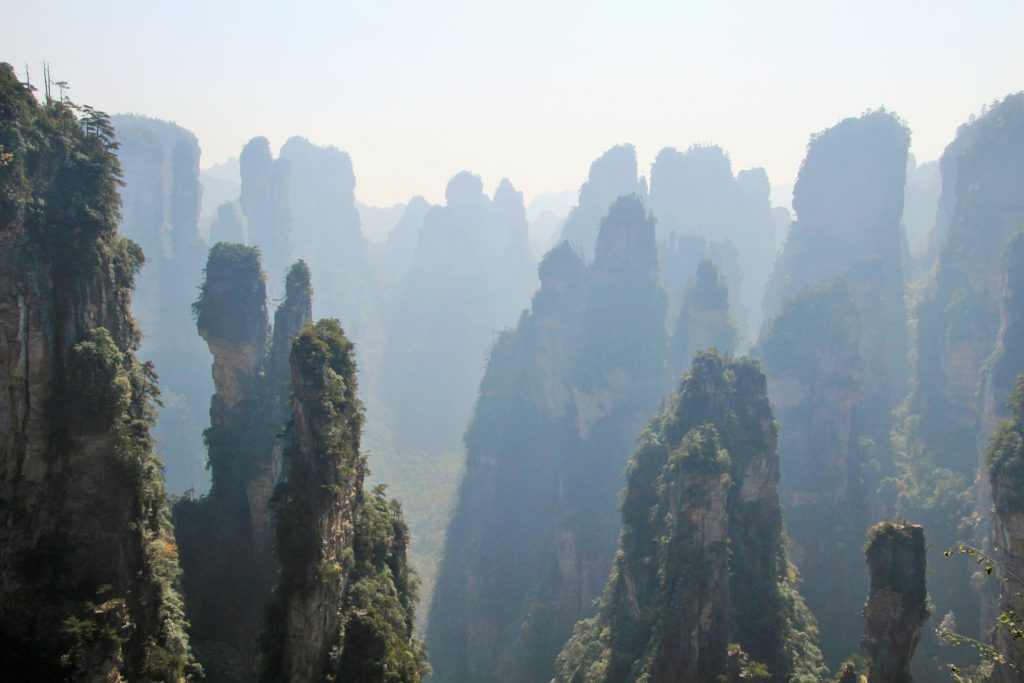
Karsts as far as the eye can see.
To finish off our first day, we hiked down a long, annoying ridge that consisted of thousands of steep stone stairways, punctuated by Chinese tourists blasting music from their cell phones and chattering loudly non-stop. [Editor’s note: In a country full of incredibly annoying Chinese tourists, this was easily the most annoying single incident in our trip. While the Chinese are great at going to nature sights, they aren’t great at enjoying the tranquility of nature (their forte is really just taking a ton of pictures and checking stuff off a list).] Not the most relaxing way to end a long day, but eventually we made it down to a mini tram-like train that took us back to the free buses back to Wulingyuan for the evening.
Day 2: The next day, our calves screaming at us from the stairs the day prior, we headed back into the park and this time took the world’s largest outdoor elevator up to the top of the plateau.
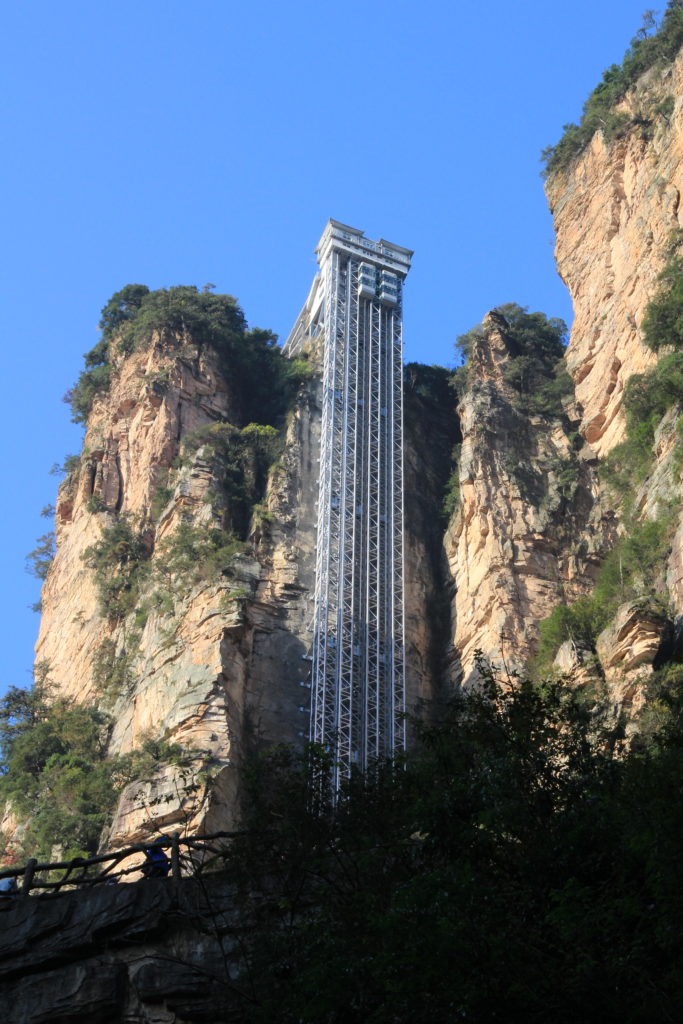
World’s biggest (we’re pretty sure) outdoor elevator.
This morning was dedicated to the best sights in the park, with names like Ecstasy Terrace and the marketing-savvy, if on-the-nose, “Avatar Floating Mountains”. This, while crowded, was the pinnacle of insane views, and we dutifully fought through the crowds to stare down at the impossible peaks below us. We were blessed with great weather both days, and I was able to take hundreds (literally) of photos, convinced that each one was better than the last. [Editor’s note: I can’t emphasize enough just how phenomenally beautiful these mountains were. It’d be a bit basic to call it breathtaking, but completely accurate. These mountains have arguably overtaken Plitvice National Park in Croatia as the most beautiful natural site that I’ve ever visited.]
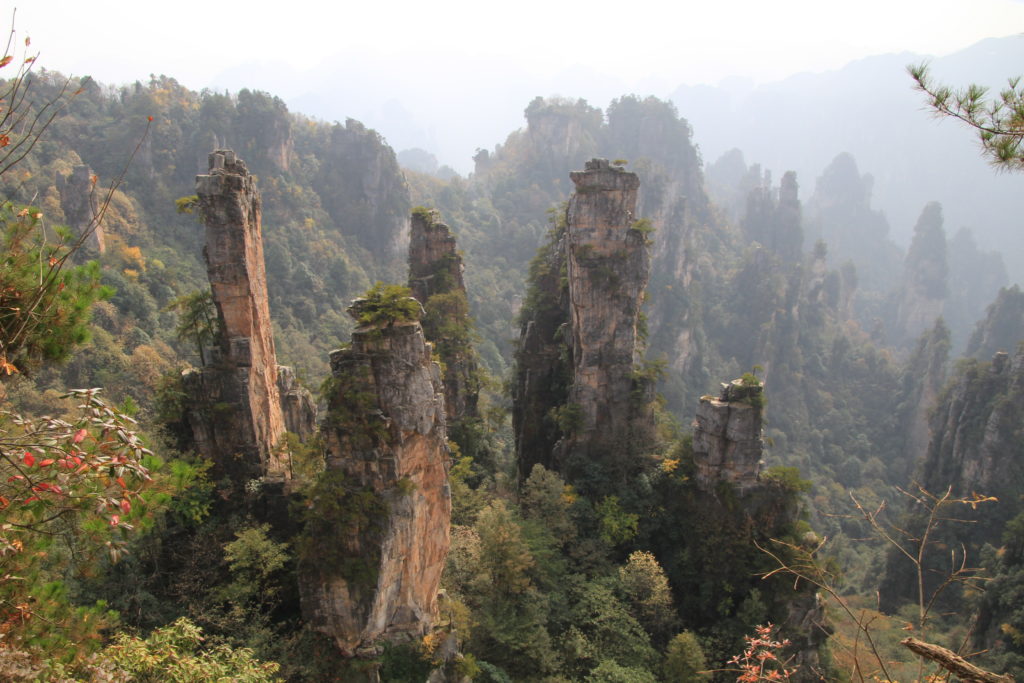
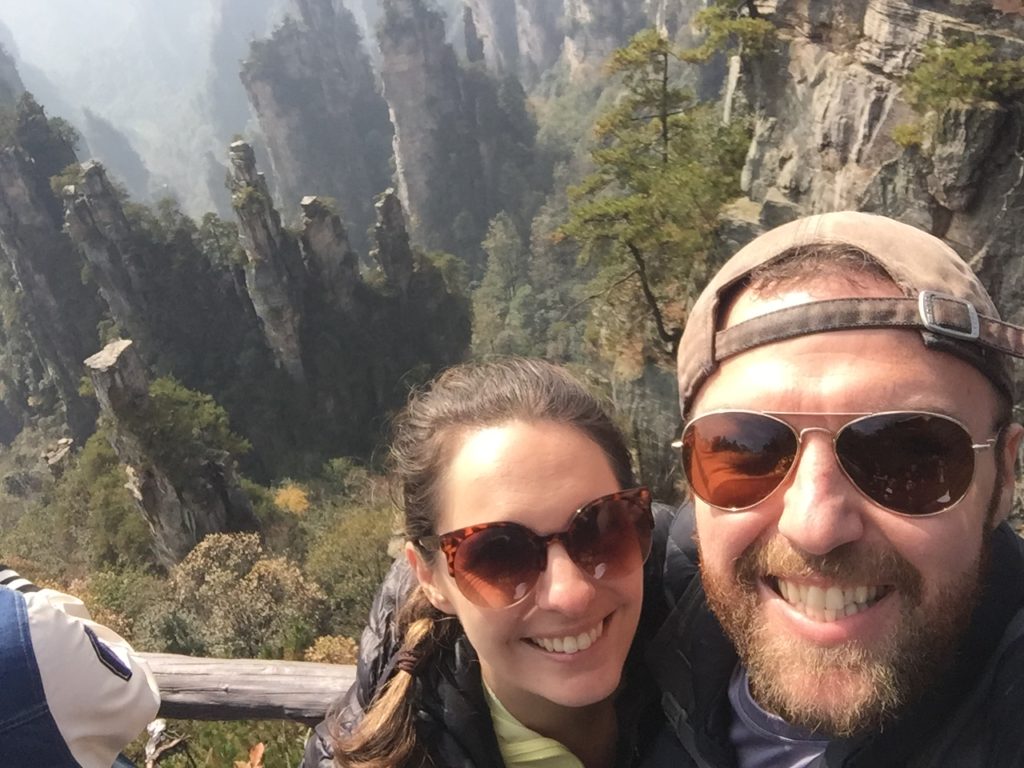
It was really hard to capture the epic scale and get people in the photos at the same time.
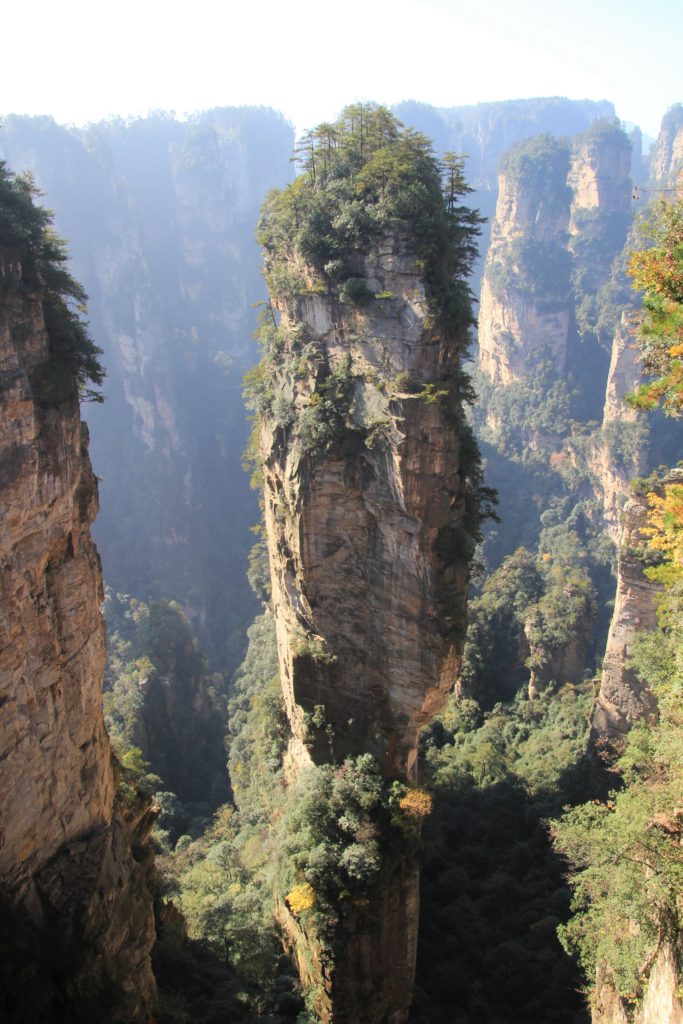
An incredible standalone karst
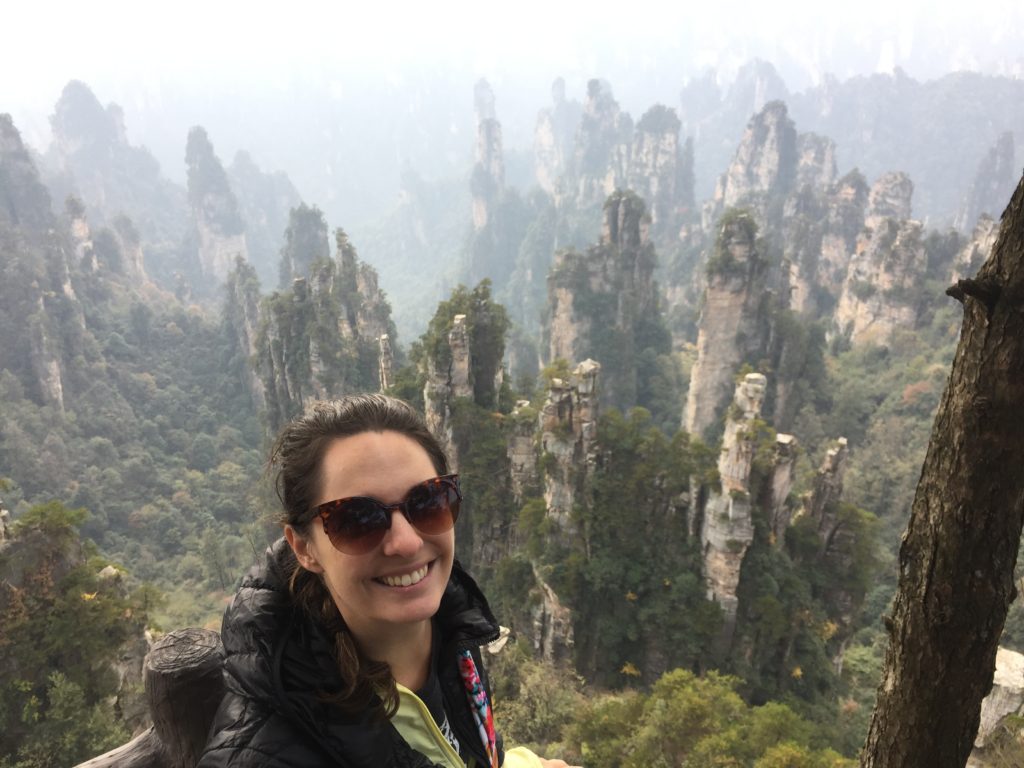
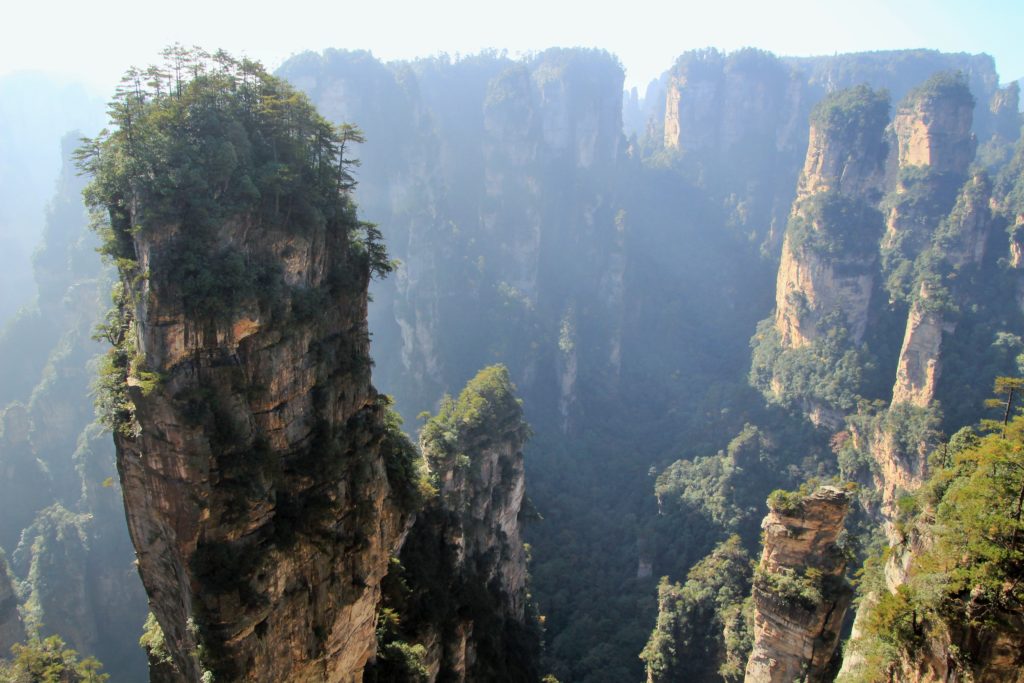
The only hiccup our second day was that it happened to fall on the day of the Zhangjiajie Mountain Marathon, which apparently requires runners to actually scale at least portions of the mountain. Despite being told multiple times by marathon staff that the race would not impact our day, of course the part of the path we wanted to take back down the mountain at midday was closed off for the runners. Instead, we backtracked the route with the incredible sights again, taking them all in a second time at our leisure. By the time we were finally able to walk down the path after the race (with straggler runners passing us occasionally, to our clapping and cheers), it was too late to make it to the second area of the park I had planned so we just took our time strolling alongside a beautiful river at the bottom of the valley.
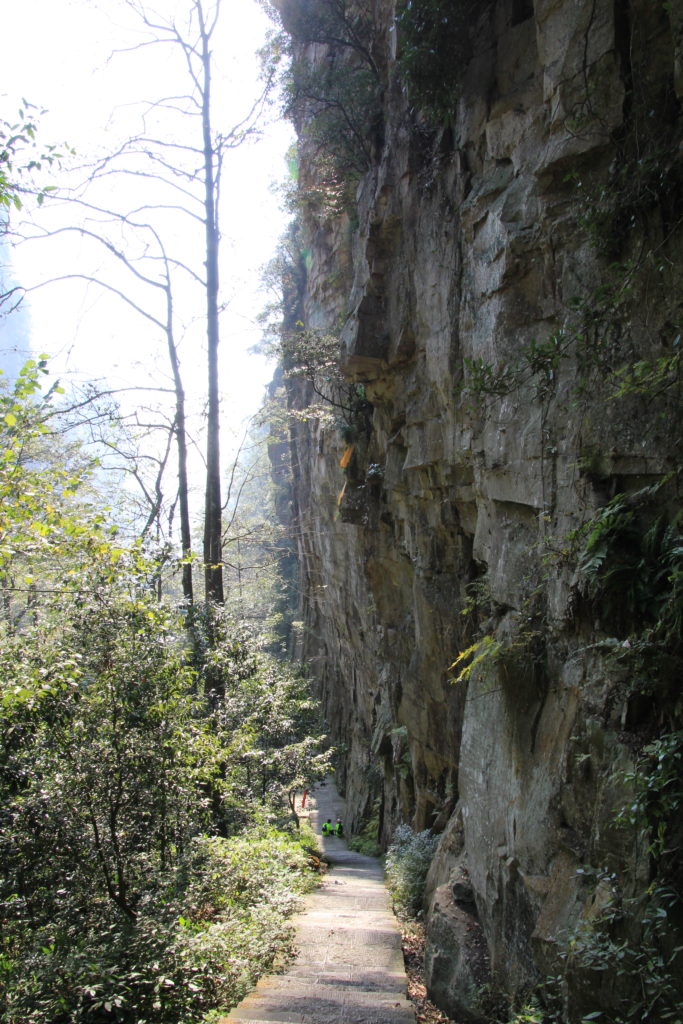
A rare flat part of the path down the side of the mountain.
Plus, on the walk down we finally saw some of the resident monkey troupes we’d heard about! Rorie wasn’t a huge fan [Editor’s note: They were really cute, but not to be trusted. One tried to pull my day pack off my back. They also have been known to bite tourists (Rabies. Yay!), so I wasn’t super pumped about lingering amongst them unnecessarily so Jess could snap a bajillion pictures.], but I loved standing in the middle of the group, watching the monkeys move about the path and the forest without a care in the world for the people around them (except for those people who were holding food, which of course were subjects of much monkey interest).

Look how cute! A young monkey on the railing of the pathway.
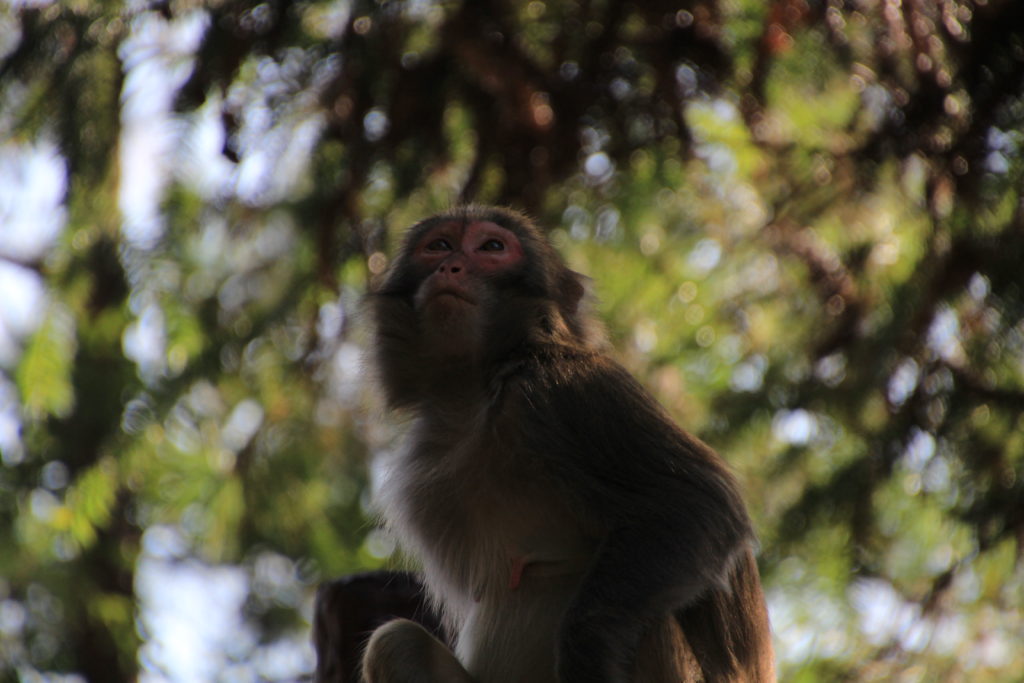
Thus we ended our two full days in Zhangjiajie National Forest. There were large portions of the park we didn’t make it to, but we felt like we’d seen what we came to see and were able to leave perfectly satisfied. The next two days were dedicated to other natural sights, the Zhangjiajie Grand Canyon (famous for its glass bridge) and Tianmen Mountain (famous for the natural break in the rocks known as Heaven’s Gate, and the 999 steps it takes to get there).
Those adventures (with photos of course) coming in the next post!
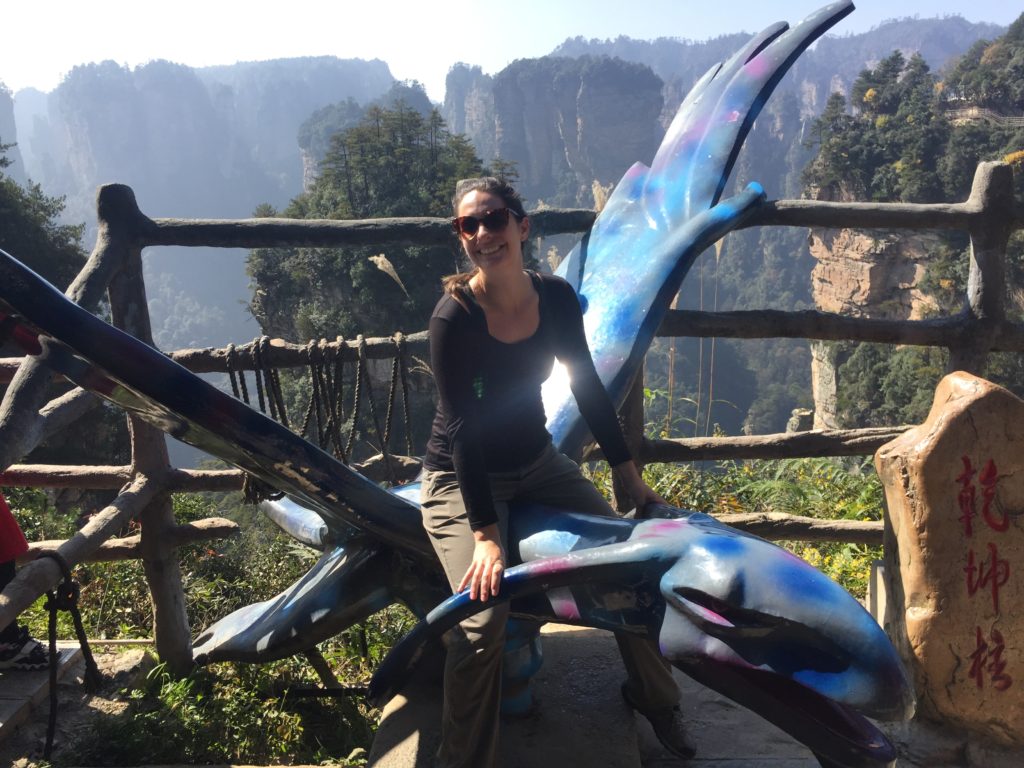
Ok fine, here I am sitting on the Avatar statue because I know you were going to ask.
